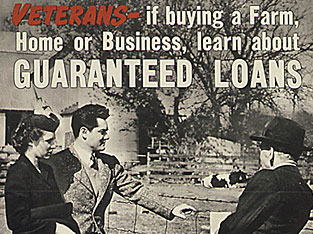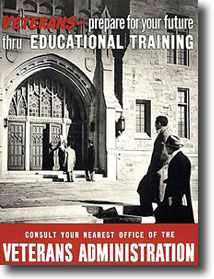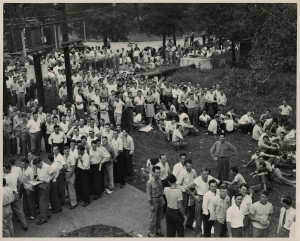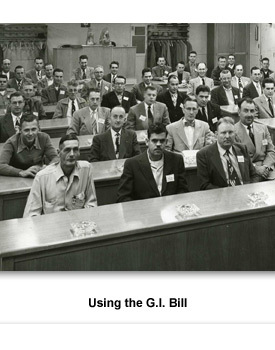

After WWI, veterans were given $60 and a train ticket home. You may recall the 1932 Bonus Army march, and a survey conducted during WWII revealed that 56% of soldiers anticipated a postwar depression. The Servicemen’s Readjustment Act passed Congress in June of 1944 (Senate votes 50-0, House 387-0), a week after D-Day, though there was significant debate over the provision to pay unemployed former servicemen $20/week for up to a year. (In fact, less than 20% of the money set aside for this was used.) It covered anyone, regardless of region, class, ethnicity or race, who had served at least 90 days and had not received a dishonorable discharge. On its 50th anniversary, Bill Clinton called it “FDR’s most enduring legacy….[It] gave generations of veterans a chance to get an education, to build strong families and good lives, and to build the nation’s strongest economy ever, to change the face of America.”


The GI Bill reaches 8 of 10 men born in 1920s. Total of $95B spent 1944-71. Comprises 15% of federal budget, 1948, and VA employs 17% of federal workforce. Veterans are 49% of college admissions, 1947; by 1950, US has spent more on veterans’ education (in most cases, pays full tuition, plus a living stipend based on family size) than on Marshall Plan. In 1940, about 160,000 Americans graduate college every year; in 1950, it’s 500,000. By 1956, when GI Bill (for WWII vets; separate versions applied for Korean and Vietnam wars) ends, 7.8M (of 16M total) of WWII vets have participated in an education or training program. Nearly 2.4M home loans were extended, and the VA issued mortgages for nearly 5M new homes. (Before WWII, banks usually demanded 50% of the price down and set short loan periods, limiting home ownership to the wealthy. GI Bill loans were capped at lower interest rates and waived the down payment for up to 30 years.) 13M new homes are built in US, 1945-54 alone: “as surely as the Homestead Act of 1862 filled the prairies of the Far West, the GI Bill created and filled the suburbs.”
 |
 |
Ira Katznelson, When Affirmative Action Was White: “written under Southern auspices, the law was deliberately designed to accommodate Jim Crow. Its administration widened the country’s racial gap. The prevailing experience for blacks was starkly differential treatment.” Participation rates are more or less equal: a 1950 survey reveals that 73% of whites and 75% of non-whites have participated; another shows that 51% of black veterans and 44% of whites have done so.
BUT: benefits are administered not through federal government but through the states, allowing Southern states to maintain segregation, even though all of the money comes from the federal government. Mississippi Senator John Rankin, one of segregation’s foremost defenders, is particularly worried by Title II of the Bill (any veteran “shall be eligible for and entitled to such course of education or training as he may elect, and at any approved educational or training institution at which he chooses to enroll”), explaining that “a definite line should be drawn in the schooling on the matter of race segregation.” This restricts opportunity hugely for blacks in the South, where they are 25% of the population, but white schools outnumber black schools more than 5-1 in 1947 (545 white, 102 black). In Mississippi, more than 50% of population is black, but just 7 of 33 colleges; in Tennessee, 8 of 35. The few available schools are also smaller, with 90% educating less than 1000 students, and of low quality, with 5% or so being accredited by the Association of American Universities. In 1947, therefore, in the South 20,000 black veterans cannot find a college spot; as many as 50,000 others might have sought admission had there been opportunities. Historically-black colleges have to turn away 55% of applicants for lack of space, as compared to 28% of all colleges. (Also, very few women of any race do so: only 3% of 350,000 who are eligible.) In 1940, enrollment at black colleges was 1.08 percent of the total U.S. college enrollment; in 1950, it was 3.6 percent.
 registration at the University of Houston, 1946.
registration at the University of Houston, 1946.
 an engineering school in Tennessee, 1948
an engineering school in Tennessee, 1948
As a result, education gaps widen: of veterans born 1923-28, 28% of whites and 12% of blacks enroll in college-level programs; black veterans spend less time in college as well. Applies for agricultural training, too, where training black veterans to run farms would weaken the sharecropping system; 1% of 350,000 black veterans drafted from farms receive government training. By 1946, job-training programs in S have enrolled just 7700 blacks out of 102,000 participants; one study estimates that only 1/12 of the programs are even open to blacks. This remains true later on as well: in 1973, only 25 percent of African-American veterans had used their education benefits, compared to 46 percent of white veterans.
In housing, VA does not make loans, it just guarantees them, meaning that black vets must get a local bank to lend to them. Unsurprisingly, this does not happen. Levittown (on Long Island, NY) was segregated, and in NY/northern NJ, less than 100 of 67,000 GI-Bill supported mortgages go to non-whites. In 1947, Ebony surveys 13 Mississippi cities and finds that 2 of 3229 loans (home, business, farm) have gone to blacks.
Long-term impact: in 1984, the median white household has a net worth of $39,000; median black household $3400, mostly accounted for by differences in homeownership. (Figures are $81,000 and $8000, 2000.) Nearly 70% whites own homes, with average value of $52,000; only 40% of blacks do with, with median value of under $30,000.